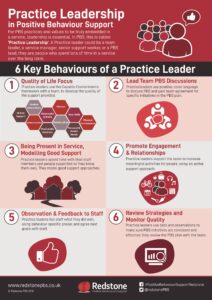An increasing number of organisations are implementing Positive Behaviour Support (PBS) as standard into their services. Regulatory bodies and those who commission services recognise that PBS is key to both providing high quality services, and an effective way to reduce behaviours of concern and the use of restrictive practices.
However, it is important to understand that the potential for PBS to improve quality of life and reduce behaviours of concern can only be achieved through PBS being implemented well and maintained successfully over the long term. It is clear from the many services that we have worked with, having a strategy and having a training plan are necessary for implementing PBS, but they are not sufficient alone. What makes the difference is staff at all levels of an organisation have an understanding PBS and what they need to DO in their role. Central to this is Practice Leadership.
Much of the research around practice leadership is linked with Active Support. Active Support is an approach to training and coaching staff to be able to maximise participation and engagement and is implemented within the PBS framework. Whilst the outcomes from Active Support can be extremely beneficial, research has shown that unless services have a practice lead in place, implementation and subsequent outcomes can be less than ideal. From our perspective, this also applies to other interventions implemented as part of PBS.
What is Practice Leadership?
A practice leader is someone who is either based within a service or who spends lots of time within it. This may be the team leader, service manager or another member of staff who is regularly at the service over the long term. Based on the research around active support and practice leadership, we have outlined six key behaviours of a practice leader in PBS. The aim of this information is to help to clarify what is needed to get practice leadership in place and well embedded within services; rather than just an add on. We also know that if PBS is viewed as the sole responsibility of a specialist professional, it will not be implemented into a service over the long term.
Six Key Behaviours of a Practice Leader
1. Quality of Life Focus.
Practice leaders use the Capable Environments framework to lead a team in developing the quality of the support service. While PBS is associated with behaviours of concern, the method by which we reduce these issues is primarily through improving quality of life. If a person has all their core needs met; for communication, activities, health, a suitable home, sensory needs, relationships and positive interactions with others, as well as predictable routines and activities, they are much less likely to present with behaviours of concern. While many services understand that a good quality of life is a human right, they don’t always see how behaviours of concern are linked to this. The capable environments framework is a great way for services and teams to think about the key areas which will improve quality of life for people they support.
2. Lead PBS Discussions.
Practice leaders use positive clear language to discuss PBS, and gain team agreement for specific initiatives in the PBS plan. To be able to do this, practice leaders need to have a good knowledge of PBS, in terms of understanding what improves quality of life, the capable environments framework and understanding why behaviours of concern occur. They also need to be confident leading team discussions around choosing specific support strategies. This means dealing with differences of opinions and gaining agreement. They need to be able to facilitate the engagement of the person supported, so that where possible they also have input into their own plan. Practice leaders need to be able to write up agreed strategies into a PBS plan, so that it is a clear record of what staff are currently doing.
3. Being present in the service & modelling good support.
Practice leaders spend time with staff members and people supported so they know them well. With this knowledge they can model good support approaches. Visiting a service once every few weeks or months isn’t sufficient to truly know and understand both the staff team members, or the people supported. While external professionals may need to work in this way due to their job role and may provide some of the more technical understanding around behaviours of concern; the role of the practice leader is different. They need to be able to test out approaches to see if they will work, and to understand why staff members may not think an approach is practical or doable. Once appropriate support strategies are identified, agreed and established, it’s the practice leader who should work with the team to model these strategies.
4. Promote engagement and relationships.
As previously discussed in our blog and infographic here, Active Support is an approach which ensures people supported can have maximum participation and engagement in meaningful activities. This is one of the key ways that the practice leader can improve quality of life for people supported, and coaching, covered in point five, is an essential element of Active Support.
5. Observation & Feedback to staff
Practice leaders need to tell staff what they did well, using behaviour specific praise; and agree next goals with them. Whether it is maximising participation and engagement, following a specific support strategy or following a reactive management plan, practice leaders need to be able to tell staff what they are doing right. Often we focus too much on pointing out errors, but by using behaviour specific praise, telling staff what they did right, we can build on their skills and motivation. Practice leaders need to observe staff, making sure they know why this is happening, and that it will happen both at formal times and more informally in the course of a usual day. This helps to reduce any anxiety about being observed, especially when staff know it’s the same for the whole team. Building this into staff understanding of the role of the practice leader can also make it a normal part of what happens at work.
6. Review Strategies & Monitor Quality
Practice leaders use data and observation to make sure PBS initiatives are consistent and effective; they review the PBS plan with the team. While talking with a team and observing their practices provides great information, having other sources of information, such as data recorded by the team on a daily or incident basis, is important . It helps to work out whether a specific support strategy is working. This sort of data might include paper based recording about a specific support strategy, ABC recordings or behavioural incidents, including restrictive techniques or other restrictions. With this information the practice leader can review the PBS plans and support approaches with the team, an external professional, the person and/or their family; looking at where changes might need to be made. Using a visual representation of change in quality of life or behaviours of concern can really help everyone see that sometimes positive changes are gradual, or that an approach which has been in place for a while, is not working and needs to be changed.
To Conclude
The main aim for a practice leader is to ensure that staff can implement PBS initiatives consistently and effectively, so that they make a real difference in people’s lives. No one is on shift all the time, so if the team can do a great job when no one is looking, the practice leader has achieved a really good result. Their role then is to keep things on track through regular review and discussion with the team, external professionals or specialists, the person and /or family, as well as working with any new challenges! While it may take some work initially, taking this approach will result in far fewer crises, which become time consuming themselves; and potentially avoid staff burn out and sickness. If you and your organisation are looking to develop practice leadership skills you can find more information here.
If you’re interested in receiving further blogs or information about PBS, training and offers to your inbox click here.
Further Reading
Bould (2018). The role of practice leadership in active support: impact of practice leaders’ presence in supported accommodation services. International Journal of Developmental Disabilities 64(2):75-80
Deveau and McGill (2014). Leadership at the front line: Impact of practice leadership management style on staff experience in services for people with intellectual disability and challenging behaviour. Journal of Intellectual & Developmental Disability 39(1):65-72.
Mansell and Beadle-Brown (2012). Active Support: Enabling and Empowering People with Learning disabilities.
Authors
Sarah Hobson – Behaviour Analyst
Sarah is a behaviour analyst and has worked in the field of applied behaviour analysis and positive behaviour support with children and young adults with autism for five years. She initially gained her training whilst working at a specialist in London; progressing from a Trainee Tutor to a Senior Tutor before moving onto working on early intervention programmes for specific children in their home settings. Sarah’s main strengths include working on early intensive behavioural interventions, delivering functional communication training interventions (such as PECs, Proloquo2go or Makaton), working with those who engage with behaviours that challenge, and delivering skill building programmes. Sarah has an MSc in Applied Behaviour Analysis from Bangor University
Kate Strutt – Director of Redstone PBS and Clinical Psychologist.
Kate has over 20 years’ experience of working with adults and children with intellectual disabilities and those who are autistic, both within statutory services and the independent sector. Kate is registered with the Health and Care Professions Council. Bsc Psychology, D.Clin Psyc, MSc Applied Behaviour Analysis.











